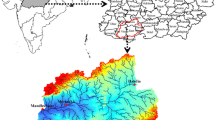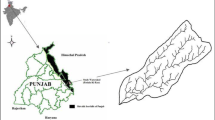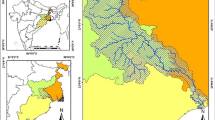Abstract
The landuse/land cover change has a significant influence on the hydrological response of a river basin. The run-off characteristics are naturally changing due to reduction of initial abstraction that increases run-off volume. Thus, it is necessary to quantify the changes in the run-off characteristics of a catchment that occur due to changes in landuse/land cover. These changes can be sudden or continuous. Physically based conceptual models have developed to find out surface run-off, and one of the models used in the present study is the Soil Conservation Service curve number (SCS-CN) model which has a broad range of applications. The present study is on the application of the SCS-CN model to analyse the impact of various landuse/land cover change in the run-off characteristics of a catchment of Narmada basin in Madhya Pradesh, India. The study includes the preparation of a landuse/land cover map of different years from the satellite imageries, drainage network, and development of a database by using a geographic information system (GIS) and a run-off generation with the model to estimate the impact of landuse change on run-off.







Similar content being viewed by others
References
Beven KJ (2000) Rainfall-runoff modelling: the primer. Wiley, New York
Bosch JM, Hewlett JD (1982) A review of catchment experiments to determine the effect of vegetation changes on water yield and evapotranspiration. J Hydrol 55:3–23
Brath A, Montanari A, Moretti G (2003) Assessing the effects on flood risk of the land-use changes in the last five decades: an Italian case study. IAHS Publ 278:435–441
Braud I, Vich AIJ, Zuluaga J, Fornero L, Pedrani A (2001) Vegetation influence on runoff and sediment yield in the Andes region: observation and modelling. J Hydrol 254:124–144
Brocca L, Melone F, Moramarco T (2008) On the estimation of antecedent wetness conditions in rainfall-runoff modelling. Hydrol Process 22:629–642
Bronstert A, Niehoff D, Burger G (2002) Effects of climate and land-use change on storm runoff generation: present knowledge and modelling capabilities. Hydrol Process 16:509–529
Bultot F, Dupriez GL, Gellens G (1990) Simulation of landuse changes and impacts on the water balance—a case study for Belgium. J Hydrol 114:327–348
Chow VT, Maidment DR, Mays LW (1988) Applied hydrology. McGraw-Hill International Editions, Singapore
Congalton RG (1991) A review of assessing the accuracy of classifications of remotely sensed data. Remote Sens Environ 37:35–46
De Roo A, Odijk M, Schmuck G, Koster E, Lucieer A (2001) Assessing the effects of landuse changes in the Meuse and Oder catchment. Phys Chem Earth B 26:593–599
Fohrer N, Haverkamp S, Eckhardt K, Frede HG (2001) Hydrologic response to landuse changes on the catchment scale. Phys Chem Earth B 26:577–582
Foody GM (2002) Status of land cover classification accuracy assessment. Remote Sens Environ 80:185–201
Gandini ML, Usunoff EJ (2004) SCS Curve Number estimation using remote sensing NDVI in a GIS environment. J Environ Hydrol 12 (Paper no. 16)
Hibbert AR (1967) Forest treatment effects on water yield. In: Sopper WE, Lull HW (eds) International symposium on forest hydrology. Pergamon, Oxford, p 813
Hollis GE (1975) The effect of urbanization on flood of different recurrence interval. Water Resour Res 11:431–435
Jain MK, Mishra SK, Sureshbabu P, Venugopal K, Singh VP (2006) Enhanced run-off curve number model incorporating storm duration and a nonlinear ia-S relation. J Hydrol Eng ASCE 11:631–635
Kannan N, Santhi C, Williams JR, Arnold JG (2008) Development of a continuous soil moisture accounting procedure for curve number methodology and its behaviour with different evapotranspiration methods. Hydrol Process 22:2114–2121
Kim Y, Engel BA, Lim KJ (2002) Runoff impacts of landuse change in Indian river Lagoon watershed. J Hydrol Eng 7:245–251
Kokkonen TS, Jakeman AJ (2002) Structural effects of landscape and landuse on streamflow response. In: Beck MB (ed) Environmental foresight and models: a manifesto. Elsevier, Oxford, pp 303–321
Landis JR, Koch GG (1977) The measurement of observer agreement for categorical data. Biometrics 33:159–174
Langford KJ (1976) Change in yield of water following a bush fire in a forest of Eucalyptus regnans. J Hydrol 29:87–114
Lørup JK, Refsgaard JC, Mazvimavi D (1998) Assessing the effect of land use change on catchment runoff by combined use of statistical tests and hydrological modeling: case studies from Zimbabwe. J Hydrol 205:147–163
Michel C, Vazken A, Perrin C (2005) Soil conservation service curve number method: how to mend a wrong soil moisture accounting procedure. Water Resour Res 41:1–6
Mishra SK, Singh VP (1999) Another look at the SCS-CN method. J Hydrol Eng ASCE 4:257–264
Mishra SK, Singh VP (2002) SCS-CN based hydrological simulation package. In: Singh VP, Frevert D (eds) Mathematical models in small watershed hydrology and applications. Water Resources Publications, Littleton, pp 391–464
Mishra SK, Singh VP (2006) A relook at NEH-4 curve number data and anticident moisture condition criteria. Hydrol Process 20:2755–2768
Mishra SK, Jain MK, Pandey RP, Singh VP (2005) Catchment area-based evaluation of the AMC-dependent SCS-CN-based rainfall-runoff models. Hydrol Process 19:2701–2718
Mishra SK, Pandey RP, Jain MK, Singh VP (2008) A rain duration and modified AMC SCS-CN procedure for long duration rainfall-runoff events. Water Resour Manag 22:861–876
National Bureau of Soil Survey & Landuse Planning (NBSS) (1996) Soils series of Madhya Pradesh. Indian Council, Indian Council of Agricultural Research, Nagpur
Nayak TR, Jaisawal RK (2003) Rainfall-runoff modelling using satellite data and GIS for Bebas river in Madhya Pradesh. Inst Eng (IEI) 84:47–50
Okoński B (2007) Hydrological response to land use change in central European lowland forest catchment. J Environ Eng Landsc Manag 15:3–13
Pandey A, Sahu AK (2002) Generation of curve number using remote sensing and geographic information system. (Link: http://www.gisdevelopment.net/application/nrm/water/watershed/watws0015pf.htm)
Parkin G, O’Donnell G, Ewen J, Bathurst JC, O’Connell PE, Lavabre J (1996) Validation of catchment models for predicting land-use and climate change impacts. 1. Case study for a Mediterranean catchment. J Hydrol 175:595–613
Ponce VM, Hawkins RH (1996) Runoff curve number: has it reached maturity? J Hydrol Eng ASCE 1:11–19
Ranzi R, Bochicchio M, Bacchi B (2002) Effects on floods of recent afforestation and urbanisation in the Mella River (Italian Alps). Hydrol Earth Syst Sci 6:239–253
Sahu RK, Mishra SK, Eldho TI, Jain MK (2007) An advanced soil moisture accounting procedure for SCS curve number method. Hydrol Process 21:2872–2881
Schneider LE, McCuen RH (2005) Statistical guidelines for curve number generation. J Irrig Drain Eng ASCE 131:282–290
Schreider SY, Jakeman AJ, Letcher RA, Nathan RJ, Neal BP, Beavis SG (2002) Detecting changes in streamflow response to changes in non-climatic catchment conditions: farm dam development in the Murray–Darling basin. Aust J Hydrol 262:84–98
Smits PC, Dellepiane SG, Schowengerdt RA (1999) Quality assessment of image classification algorithms for land-cover mapping: a review and a proposal for a cost-based approach. Int J Remote Sens 20:1461–1486
USDA Soil Conservation Service (1972) National engineering handbook section 4 hydrology. Chapters 4–10
USDA Soil Conservation Service (1983) National engineering handbook section 4 hydrology. Chapter 19
Soulis KX, Valiantzas JD, Dercas N, Londra PA (2009) Investigation of the direct runoff generation mechanism for the analysis of the SCS-CN method applicability to a partial area experimental watershed. Hydrol Earth Syst Sci 13:605–615
Stehman SV, Czaplewski RL (1998) Design and analysis for thematic map accuracy assessment: fundamental principles. Remote Sens Environ 64:331–344
Story M, Congalton RG (1986) Accuracy assessment: a user’s perspective. Photogramm Eng Remote Sens 52:397–399
Stuebe MM, Johnston DM (1990) Run-off volume estimation using GIS techniques. J Am Water Resour Assoc 26:611–620
USDA-SCS (1985) National engineering handbook, section 4 hydrology. USDA-SCS, Washington, D.C
Wooldridge S, Kalma J, Kuczera G (2001) Parameterisation of a simple semi-distributed model for assessing the impact of landuse on hydrologic response. J Hydrol 254:16–32
Yang TC, Yu PS (1998) The effect of land-use change on the design hydrograph. J Hydrol Chang Environ 3:207–216
Zhan X, Huang M (2004) Arc CN-runoff: an arc GIS tool for generating curve number and run-off maps. Environ Model Softw 19:875–879
Acknowledgments
The authors acknowledge the United States Geographical Survey (USGS) and Survey of India (SOI) for providing the Landsat satellite imagery and topographical map of the selected study area. The authors are also thankful to the Indian Meteorological Department for providing rainfall and run-off data.
Author information
Authors and Affiliations
Corresponding author
Rights and permissions
About this article
Cite this article
Khare, D., Patra, D., Mondal, A. et al. Impact of landuse/land cover change on run-off in a catchment of Narmada river in India. Appl Geomat 7, 23–35 (2015). https://doi.org/10.1007/s12518-014-0148-6
Received:
Accepted:
Published:
Issue Date:
DOI: https://doi.org/10.1007/s12518-014-0148-6




